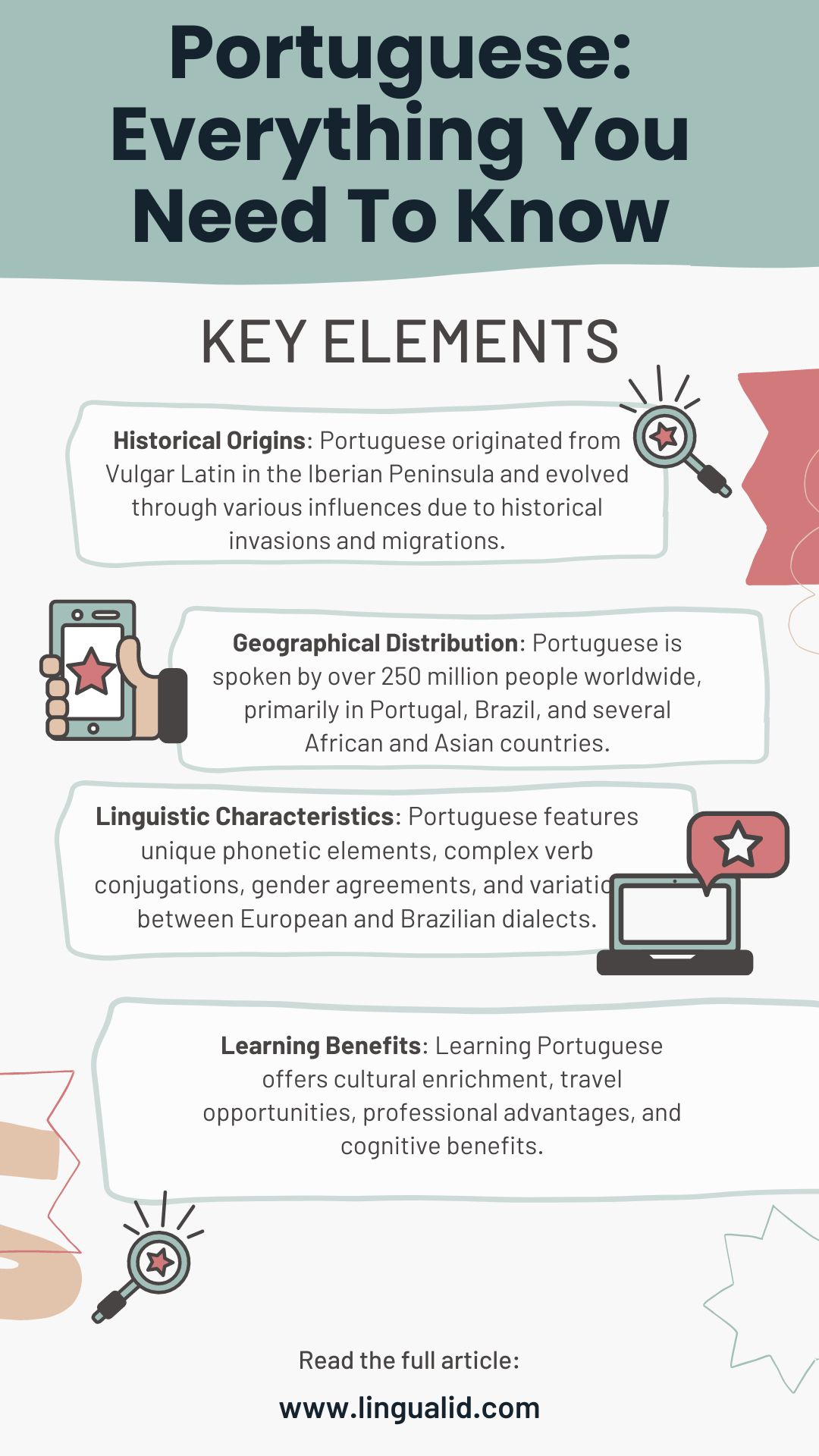Introduction
Have you ever considered how widespread the Portuguese language is? Spoken by millions across various continents, Portuguese is a Romance language with deep historical roots and holds a significant place in the linguistic landscape of the world. Let’s get started.
Key Takeaways:
- Historical Origins: Portuguese originated from Vulgar Latin in the Iberian Peninsula and evolved through various influences due to historical invasions and migrations.
- Geographical Distribution: Portuguese is spoken by over 250 million people worldwide, primarily in Portugal, Brazil, and several African and Asian countries.
- Linguistic Characteristics: Portuguese features unique phonetic elements, complex verb conjugations, gender agreements, and variations between European and Brazilian dialects.
- Learning Benefits: Learning Portuguese offers cultural enrichment, travel opportunities, professional advantages, and cognitive benefits.
- Learning Resources and Tips: Effective learning strategies include using language courses, online platforms, multimedia resources, and engaging in cultural immersion through travel, music, and cuisine.
History of the Portuguese Language
Origins in the Iberian Peninsula
Portuguese, like many Romance languages, originated in the Iberian Peninsula, an area that today comprises Portugal and Spain. Its roots trace back to the Vulgar Latin spoken by Roman settlers. When the Romans arrived on the Iberian Peninsula in the 3rd century BCE, they brought with them Latin, the language of the Roman Empire. However, it wasn’t the classical Latin of literature and formal communication that took hold among the local populations, but rather Vulgar Latin, the colloquial and everyday speech of the Roman soldiers, settlers, and administrators.
The Influence of Roman Rule
For several centuries, the Roman rule facilitated the spread and establishment of Vulgar Latin across the region. This linguistic foundation was crucial as it set the stage for the development of the Romance languages, including Portuguese. The Latin spoken in the Iberian Peninsula began to develop distinct regional characteristics, influenced by the pre-Roman languages spoken by the indigenous peoples, such as the Lusitanians and the Celts.
Historical Invasions and Migrations
The fall of the Roman Empire in the 5th century CE marked the beginning of a new era of invasions and migrations that would further shape the linguistic landscape of the Iberian Peninsula. Germanic tribes, including the Visigoths and the Suebi, invaded the region, bringing with them their own languages and customs. While their linguistic influence on the developing Portuguese was limited, they did contribute some vocabulary and impacted the social and cultural fabric of the area.
Arabic Language Influence
One of the most significant influences on the Portuguese language came from the Muslims, who ruled the Iberian Peninsula in the 8th century. The Muslims, who were Arabs and Amazigh from North Africa, ruled large parts of the peninsula for several centuries. During this period, the Arabic language left a profound impact on the Iberian languages, including Portuguese. Many Arabic words entered the Portuguese lexicon, particularly in areas related to science, agriculture, and everyday life. For example, words like “algebra” (álgebra), “sugar” (açúcar), and “olive” (azeitona) have Arabic origins.
Portuguese as a Distinct Language
By the 14th century, Portuguese had evolved into a distinct language, separate from other Iberian Romance languages such as Castilian (Spanish). The earliest known written records in Portuguese date back to the late 12th century, with documents such as the “Cantigas de Santa Maria,” a collection of religious songs. The language continued to develop and refine itself, absorbing influences from neighboring languages and adapting to the needs of its speakers.
Exploration and Global Spread
The Age of Exploration in the 15th and 16th centuries played a pivotal role in spreading the Portuguese language far beyond the borders of Europe. Portuguese explorers and traders established colonies and trading posts in Africa, Asia, and the Americas, bringing their language with them. This global spread not only expanded the reach of Portuguese but also led to the creation of various dialects and creoles, influenced by the languages of the indigenous peoples and other colonizers.
Geographical Distribution of the Portuguese Language
Portuguese in Europe
Portuguese is primarily spoken in Portugal, where it serves as the official language. Portugal, located on the westernmost edge of Europe, is the birthplace of the Portuguese language. Here, Portuguese is not just a means of communication but also a crucial part of the national identity and cultural heritage. The language is used in all facets of daily life, including government, education, media, and the arts. Lisbon, the capital city, and Porto are significant cultural and economic hubs where Portuguese thrives in both formal and informal settings.
Spread to South America
The most significant spread of the Portuguese language occurred in South America, particularly in Brazil. Discovered by Portuguese explorers in 1500, Brazil quickly became a cornerstone of the Portuguese Empire. Today, Brazil is the largest Portuguese-speaking country in the world, with over 200 million speakers. Brazilian Portuguese has developed its own distinct characteristics, influenced by the country’s diverse cultural and ethnic makeup, which includes indigenous peoples, African and European immigrants. The language plays a vital role in Brazilian society, influencing its rich traditions in music, literature, and popular culture.
Presence in Africa
Portuguese has a strong presence in Africa, a legacy of Portugal’s extensive colonial empire. Several African countries have adopted Portuguese as an official language:
Angola: With around 30 million people, Angola is one of the largest Portuguese-speaking countries in Africa. Portuguese is the lingua franca, used in government, education, and media, and serves as a unifying language in a nation with many indigenous languages.
Mozambique: In Mozambique, Portuguese is also the official language and is spoken by a significant portion of the population. It is essential in administration, education, and national media, fostering a sense of national identity.
Cape Verde, Guinea-Bissau, and São Tomé and Príncipe: These nations also recognize Portuguese as their official language. Each country has a unique linguistic landscape, with Portuguese coexisting with various Creole languages that have emerged from the blend of Portuguese and local languages.
Portuguese in Asia
Portuguese has left an indelible mark in Asia, particularly in regions once part of the Portuguese colonial empire:
East Timor (Timor-Leste): Portuguese is one of the official languages of East Timor. After gaining independence from Indonesia in 2002, East Timor reinstated Portuguese to revive its cultural ties with Portugal and Lusophone countries.
Macau: A former Portuguese colony, Macau is now a Special Administrative Region of China. Although Cantonese and Mandarin are more widely spoken, Portuguese remains an official language and is used in government documents and legal proceedings.
Goa, India: In the Indian state of Goa, a former Portuguese colony, Portuguese influence is still visible. While not an official language, Portuguese is spoken by some Goans, particularly among the older generation and in academic and cultural contexts.
Linguistic Characteristics of the Portuguese Language
Phonetics and Pronunciation
Portuguese phonetics can be complex for new learners due to its distinct sounds and nasal vowels. Here are some key features:
Nasal Vowels: Portuguese is known for its nasal vowels, which occur when air passes through the nose as well as the mouth during pronunciation. Words like “pão” (bread) and “mãe” (mother) exemplify this feature.
Consonant Sounds: Portuguese has a variety of consonant sounds that differ from English. The “r” sound can be particularly challenging; in European Portuguese, it’s often guttural, while in Brazilian Portuguese, it may be a softer, tapped sound similar to the Spanish “r.”
Vowel Reduction: Unstressed vowels in Portuguese often undergo reduction, becoming less distinct. For example, the “e” in “leite” (milk) can sound like a schwa (the “a” in “sofa”).
Intonation and Stress: Portuguese has a musical quality, with a notable rise and fall in pitch. Stress usually falls on the penultimate (second-to-last) syllable in most words, but there are many exceptions, marked by accent marks.
Grammar and Syntax
The grammar of Portuguese shares similarities with other Romance languages, but it also has unique aspects:
Verb Conjugation: Portuguese verbs are conjugated to reflect tense, mood, and person. There are regular and irregular verbs, with the latter requiring special attention due to their deviations from standard conjugation patterns. For example, “falar” (to speak) is regular, while “ir” (to go) is highly irregular.
Gender and Number: Nouns in Portuguese have gender (masculine or feminine) and number (singular or plural). Adjectives and articles must agree with the gender and number of the nouns they modify. For example, “o carro vermelho” (the red car) versus “a casa vermelha” (the red house).
Pronouns: Portuguese uses a range of pronouns, including subject pronouns (eu, tu, ele/ela, etc.), object pronouns (me, te, lhe, etc.), and reflexive pronouns (me, te, se, etc.). The use of clitic pronouns, which attach to verbs, can be particularly tricky for learners.
Sentence Structure: The basic sentence structure in Portuguese is subject-verb-object (SVO), similar to English. However, Portuguese allows for greater flexibility in word order for emphasis or stylistic reasons. For example, “Eu vi o João” (I saw João) can also be “Vi o João eu” for emphasis.
Dialects and Variations
Portuguese has several dialects, each with distinct phonetic, lexical, and grammatical features:
European vs. Brazilian Portuguese: The most significant dialectal divide is between European Portuguese and Brazilian Portuguese. Brazilian Portuguese is characterized by its more open vowels and rhythmic intonation, while European Portuguese tends to have more closed vowels and a less pronounced melodic intonation.
African and Asian Dialects: In countries like Angola and Mozambique, Portuguese has incorporated local linguistic elements, creating unique regional dialects. In East Timor, Portuguese is influenced by Tetum and other local languages.
Regional Variations Within Countries: Even within Portugal and Brazil, there are notable regional variations. In Portugal, the northern dialects (e.g., Porto) differ from the southern ones (e.g., Lisbon and Algarve). In Brazil, accents and vocabulary can vary significantly between states, with notable differences between the speech in Rio de Janeiro, São Paulo, and the northeastern states.
Learning Portuguese
Benefits of Learning Portuguese
Learning Portuguese offers numerous advantages:
Travel Opportunities: Portuguese is spoken in diverse and beautiful countries across the globe. Knowing the language enriches travel experiences in Portugal, Brazil, Mozambique, Angola, Cape Verde, and other Portuguese-speaking countries.
Professional Advantages: Portuguese can boost your career prospects, especially in fields like international business, diplomacy, and tourism. Brazil, as an emerging market, offers numerous opportunities for Portuguese speakers.
Cognitive Benefits: Learning a new language, such as Portuguese, improves cognitive functions, enhances memory, and increases mental flexibility.
Challenges in Learning Portuguese
While learning Portuguese is rewarding, it comes with challenges:
Pronunciation: Portuguese pronunciation can be tricky, particularly the nasal vowels and the guttural “r” sounds. Brazilian and European Portuguese also have distinct pronunciation patterns, which can be confusing for learners.
Grammar Complexity: Portuguese grammar involves complex verb conjugations, gender agreements, and the use of subjunctive moods. Mastering these aspects requires practice and patience.
Dialectal Variations: The differences between European and Brazilian Portuguese, as well as regional dialects, can pose a challenge. Vocabulary, expressions, and pronunciation can vary significantly.
Learn Portuguese With Lingualid
Unlock the world of Portuguese with Lingualid! Our comprehensive platform offers beginner to advanced lessons with interactive audio, engaging content, and easy-to-understand lessons. Join us and learn at your own pace. Start your journey to fluency today with Lingualid and discover the beauty of learning Portuguese!

Conclusion
The Portuguese language is a remarkable tapestry of history, culture, and linguistic richness. From its origins in the Iberian Peninsula to its global spread, Portuguese offers endless opportunities for learning, connection, and cultural appreciation. Whether you’re delving into its literature, enjoying its music, or navigating its business landscapes, Portuguese is a language that continues to captivate and inspire.
Oualid Cheddadi is the founder of Lingualid, a platform that inspires independent language learners worldwide, regardless of the language they are learning. The name “Lingualid” is derived from the Portuguese word for “language,” “língua,” and the last three letters of Oualid’s name, “Lid.”



